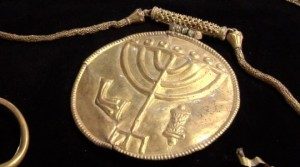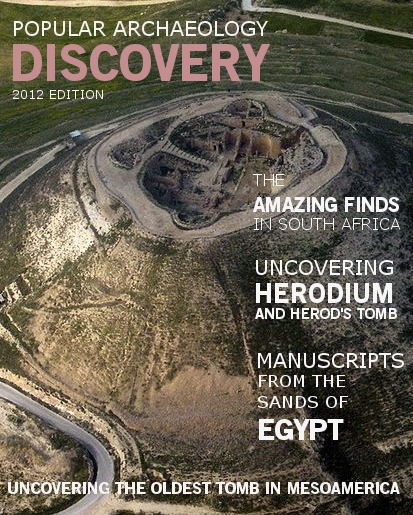
April, 2013. It was a dramatic and unexpected discovery.
Only days into the dig season, excavators were digging into a Byzantine-era structure and discovered a large gold earring. As they dug, they encounteed a second gold earring, then a number of gold coins, scattered across the area. Eventually, a beautifully preserved large gold menorah medallion buried in a depression in the floor emerged, along with a cache of jewelry beneath it. They uncovered traces of fabric on the items. Further analysis indicated that they at one time had been packaged in two separate cloth purses.
Under the direction of archaeologist Eilat Mazar of the Hebrew University of Jerusalem, the team had only just begun their dig season when, just 50 meters south of Jerusalem’s Temple Mount, they found the hoard buried inside a Byzantine structure dating back to the sixth century C.E. The hoard appeared to be divided into two parts, or bundles. One contained the menorah medallion with an attached gold chain and other jewelry and appeared to have been undisturbed since its initial burial in the floor. The other, consisting of 36 gold coins, two gold earrings, a broken gold-plated silver pendant and a pure silver ingot, was found scattered across the floor, showing clear signs that, whoever possessed them 1,400 years ago, didn’t have time to bury them.
According to Mazar, the menorah medallion and the other jewelry items found near it were likely part of a Torah scroll. If so, given the dating of the finds, it would mean that these were the earliest known Torah scroll ornaments ever discovered.
So what is the story behind this hoard?
Historical accounts document that the Persians had controlled Jerusalem before the time the hoard had been buried. But with the rising Christian empire, the Persians, as part of their effort to appease the rising Christian power, began expelling the Jews (who otherwise were previously allowed to return to Jerusalem under Persian authority) from the city. Mazar suggests that the assemblage of items might have represented payment from a group of prominent Jews to help finance the building of a synagogue in Jerusalem, consistent with historical practice. The fact that many of the items were left scattered across the ancient floor suggested a sudden abandonment under urgent conditions, perhaps relating to the expulsion by the Persians.
The discovery was made as part of the ongoing excavations in the Ophel area just south of the Temple Mount. The most recent excavations there, now in their 2nd phase, have turned up inscribed fragments featuring what has been described as an ancient Canaanite script, possibly the earliest alphabetical inscription ever found in Jerusalem, finds dated to the Second Temple, Hellenistic, Roman, and Byzantine periods, and what Mazar and others suggest may be the remains of structures attributed to builders during the period of King Solomon in the 10th century BCE. Past remains have included a section of a massive wall of large, well-dressed stones 70 meters long and 6 meters high. Also uncovered with the wall was a structure interpreted as an inner gatehouse, a royal structure adjacent to the gatehouse, and a section of a corner tower 8 meters long and 6 meters high, built of carved stones.
A detailed account of the discovery can be read in the September 9, 2013 article published in The Trumpet.
____________________________
Cover Photo, Top Left: Photo of the Menorah Medallion with chain. Photo courtesy Eilat Mazar
_______________________________________________________________________________________________________________________________________________________________
Read about the most fascinating discoveries with a premium subscription to Popular Archaeology Magazine. Find out what Popular Archaeology Magazine is all about. AND MORE:
 Popular Archaeology’s annual Discovery edition is a selection of the best stories published in Popular Archaeology Magazine in past issues, with an emphasis on some of the most significant, groundbreaking, or fascinating discoveries in the fields of archaeology and paleoanthropology and related fields. At least some of the articles have been updated or revised specifically for the Discovery edition. We can confidently say that there is no other single issue of an archaeology-related magazine, paper print or online, that contains as much major feature article content as this one. The latest issue, volume 2, has just been released. Go to the Discovery edition page for more information.
Popular Archaeology’s annual Discovery edition is a selection of the best stories published in Popular Archaeology Magazine in past issues, with an emphasis on some of the most significant, groundbreaking, or fascinating discoveries in the fields of archaeology and paleoanthropology and related fields. At least some of the articles have been updated or revised specifically for the Discovery edition. We can confidently say that there is no other single issue of an archaeology-related magazine, paper print or online, that contains as much major feature article content as this one. The latest issue, volume 2, has just been released. Go to the Discovery edition page for more information.
Subscription Price: A very affordable $5.75 for those who are not already premium subscribers of Popular Archaeology Magazine (It is FREE for premium subscribers to Popular Archaeology). Premium subscribers should email populararchaeology@gmail.com and request the special coupon code. Or, for the e-Book version, it can be purchased for only $3.99 at Amazon.com.





